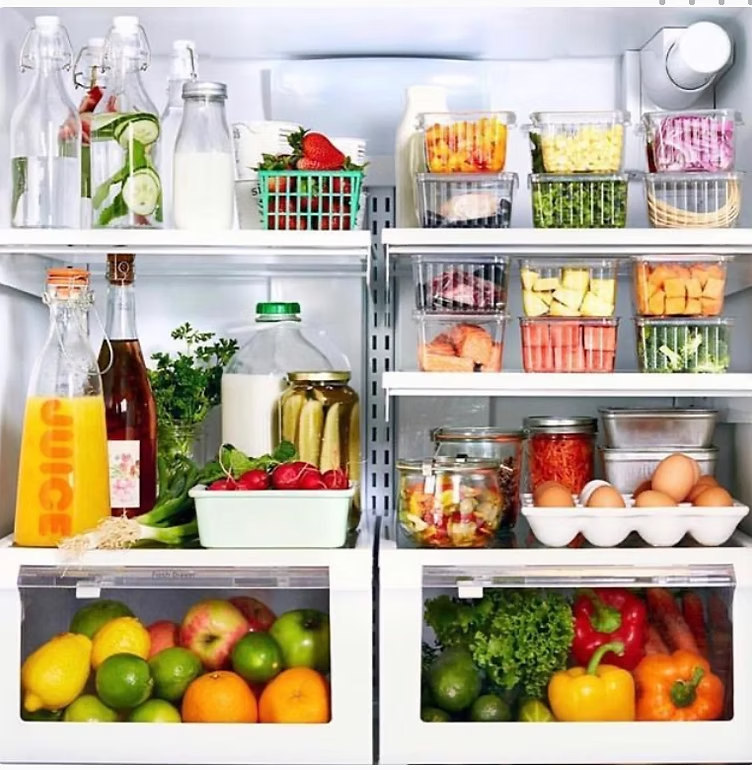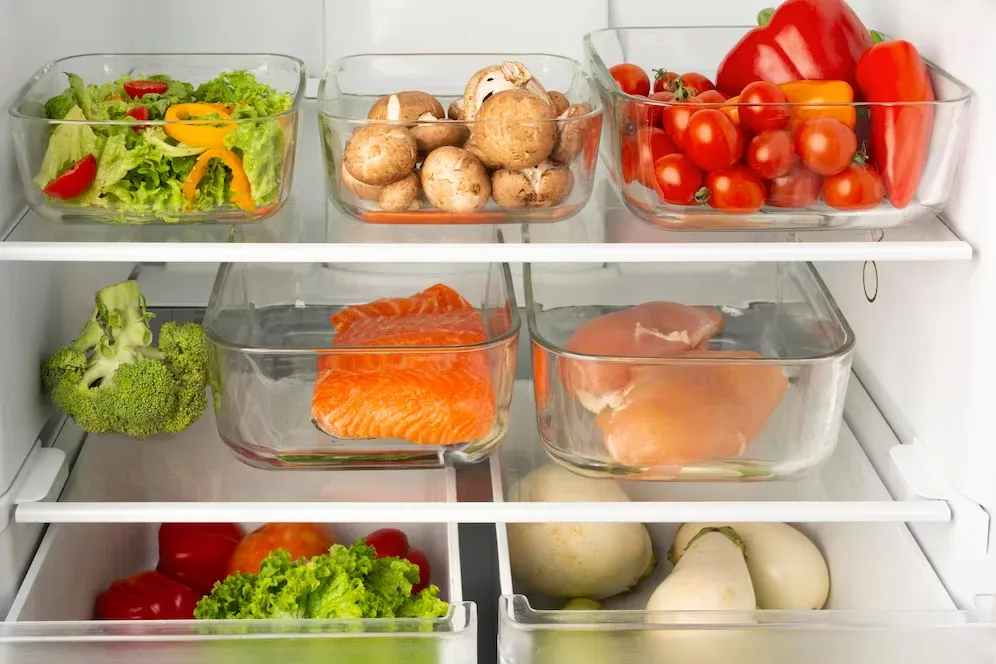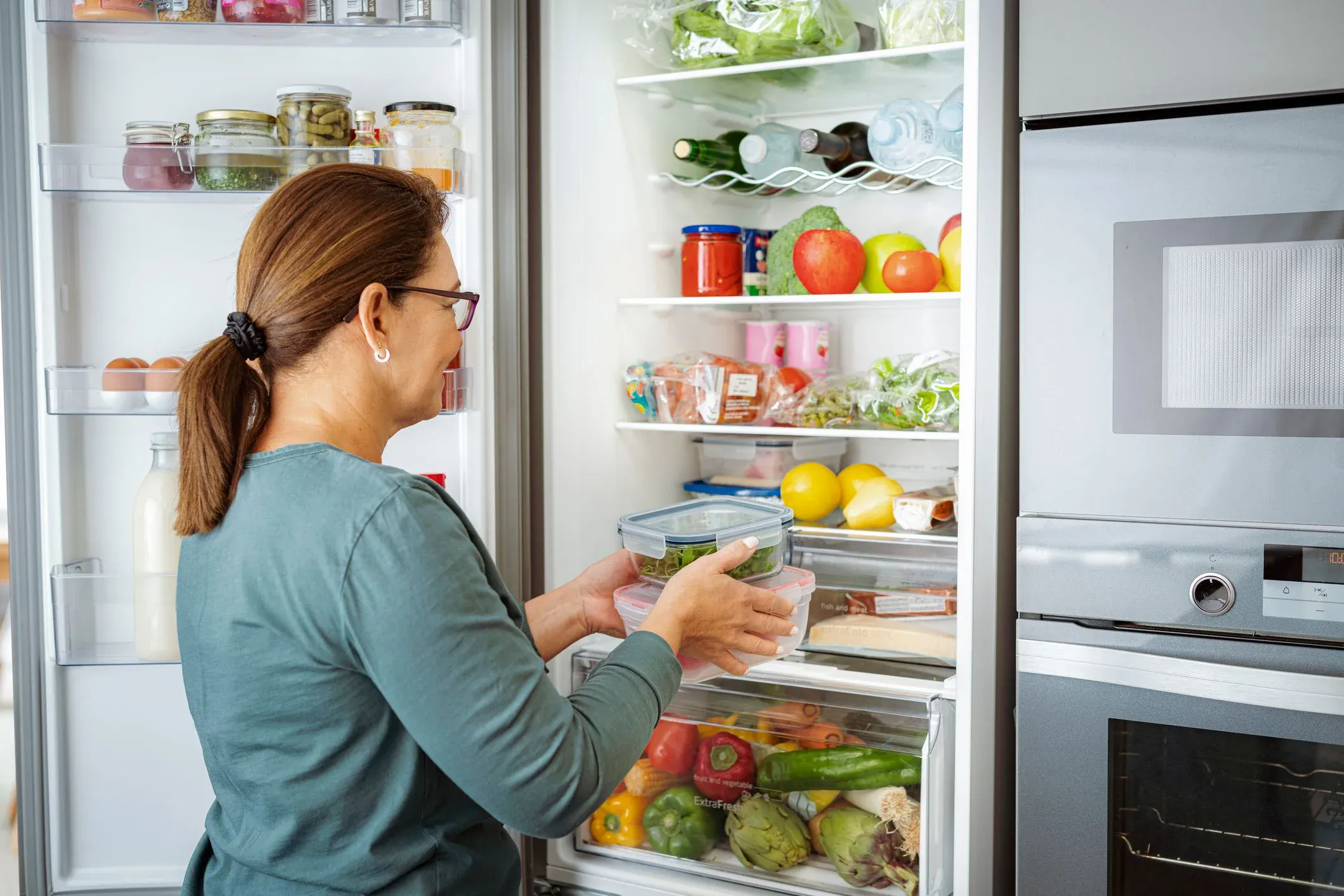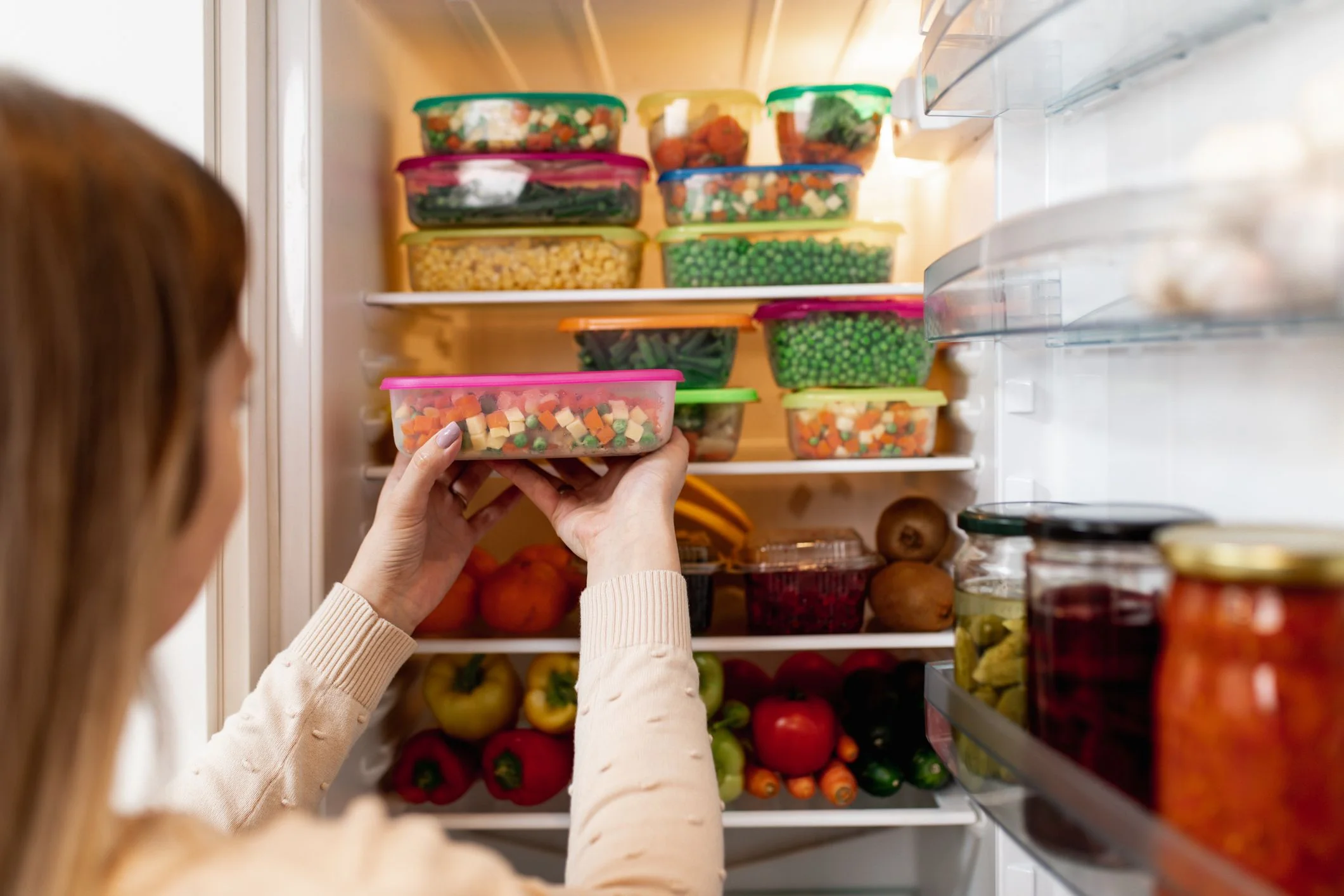How to Organize Your Refrigerator Correctly: Quick and Practical Tips
Discover how to organize your refrigerator efficiently with practical tips to better preserve food, save energy, and simplify your daily routine.
Have you ever opened your fridge and immediately wanted to close it because you couldn't find anything? Or worse, discovered that the yogurt you were looking for was right in front of you, but it was "camouflaged" among other items?
Organizing your refrigerator goes way beyond making everything look pretty. It's about practicality, saving money, and most importantly, health. When you organize food correctly, it lasts longer, you avoid waste, and you make your daily routine much easier.
In this complete guide, I'll show you step-by-step how to transform your fridge into a functional and organized space. You'll learn everything from basic cleaning to professional tricks for keeping everything in the right place.
Table of Contents
- Why Organize Your Refrigerator Correctly
- Understanding How Your Refrigerator Works
- Preparation: Before You Organize
- Where to Store Each Type of Food
- Tips for the Refrigerator Door
- Organizers and Containers: Your Best Allies
- Foods That Should NOT Go in the Fridge
- Regular Maintenance and Cleaning
- FIFO Rule: First In, First Out
Why Organize Your Refrigerator Correctly
Keeping your fridge organized isn't just about aesthetics. There are a bunch of practical benefits that make a real difference in your daily life and your wallet.
First, you save money. When food is well-organized and stored correctly, it lasts much longer. That means fewer trips to the grocery store and less food waste.
Second, you save time in the kitchen. You know that morning rush when you need to pack the kids' lunches? With everything organized, you can find ingredients in seconds, making your routine way smoother.
Third, and perhaps most important, you protect your health. Improperly stored food can develop bacteria and cause food poisoning. An organized fridge helps maintain the right temperature for each type of food.

Understanding How Your Refrigerator Works
Before diving in, you need to understand how air circulation works inside your fridge. This knowledge is key to organizing everything correctly.
Inside your refrigerator, there's a constant convection current. Cold air, which is denser, sinks from the top. Meanwhile, warm air, which is lighter, rises from the bottom. This exchange happens constantly, creating different temperature zones.
The top section of your fridge is always coldest, with temperatures between 34°F and 37°F. It's the perfect spot for foods that need intense refrigeration, like dairy products and processed meats.
The middle shelves have moderate temperatures, between 37°F and 41°F. Perfect for milk, leftovers, and some types of fruits.
The bottom section, including the crisper drawers, is less cold, with temperatures between 41°F and 46°F. This is where vegetables, produce, and fruits that don't need as much cold should go.
Preparation: Before You Organize
Before you start organizing, you need to do some basic prep work. This step is essential and can't be skipped.
Empty Your Refrigerator Completely
Take absolutely everything out of your fridge. Put foods that need to stay cold in a cooler with ice or leave them in a cool area of your house.
Do a Complete Deep Clean
Use a damp cloth with white vinegar to clean all interior surfaces. Vinegar is natural, doesn't leave odors on food, and has antibacterial properties. Avoid harsh chemical products that can contaminate your food.
Also clean the removable drawers and shelves. If possible, wash them in the sink with warm water and mild dish soap.
Toss What's Expired
Be ruthless in this step. Check all expiration dates and throw out anything that's expired or looks questionable. It's better to toss it than risk food poisoning.
Sanitize Food Items
Before putting anything back in the fridge, clean the packaging. Use soap and water or a spray bottle with 70% alcohol to clean containers, bottles, and external packaging.
Where to Store Each Type of Food
Now comes the most important part: knowing exactly where to put each type of food. The right location can significantly increase your food's shelf life.
Top Shelf (Coldest)
The top shelf is the coldest spot in your fridge, so reserve it for:
- Eggs: Contrary to what many people think, eggs should be stored inside the fridge, not in the door
- Butter and margarine that's already been opened
- Leftovers in covered containers
- Yogurt and more sensitive dairy products
- Fresh cheeses like ricotta and cottage cheese
Middle Shelves
The middle shelves are ideal for:
- Milk and dairy products in general
- Fresh juices that have been opened
- Homemade desserts in containers
- Canned foods that have been opened
- Cooked meats and deli items
Bottom Drawers
The bottom drawers are perfect for:
- Leafy greens: lettuce, arugula, spinach
- Vegetables: carrots, zucchini, eggplant
- Fruits that need refrigeration: grapes, strawberries, peaches
If you're looking to upgrade your kitchen storage, investing in a quality refrigerator with better organization features can make a huge difference in your daily routine.

Tips for the Refrigerator Door
The door is the part of your fridge that varies most in temperature because it's constantly exposed to outside air. That's why you should only use this space for foods that can handle these temperature changes.
What Can Go in the Door
- Condiments: ketchup, mustard, soy sauce
- Jams and honey (if you prefer them chilled)
- Beverages: sodas, water, commercial juices
- Salad dressings and liquid seasonings
- Butter (if you prefer to keep it chilled)
What Should NOT Go in the Door
Many people make the mistake of storing items in the door that should be on interior shelves:
- Milk: needs consistent temperature
- Eggs: are very sensitive to temperature changes
- Soft cheeses: can spoil more quickly
- Medications that need refrigeration
For better organization, consider getting some smart home devices like temperature monitors to keep track of your fridge's performance and ensure optimal food storage conditions.
Organizers and Containers: Your Best Allies
Organizers and containers are essential for keeping your fridge tidy. They not only optimize space but also protect food from contamination.
Types of Recommended Organizers
For efficient organization, invest in different types of containers:
Clear containers are ideal because you can see the contents without opening them. They're perfect for larger vegetables and salads.
Smaller organizers are great for small fruits, seasonings, and dairy products.
If you have a smaller fridge, starting with a basic set can be the perfect solution.
Organizers with Special Features
A more sophisticated option would be organizers with lids and drainage systems. These are perfect for keeping greens fresh longer by preventing moisture buildup.
Container Usage Tips
- Always use lids: protects food from odors and bacteria
- Leave space for circulation: don't fill containers to the brim
- Label with dates: especially important for leftovers
- Prefer glass for hot foods: let them cool before putting in the fridge
For a complete kitchen organization system, you might also want to check out some kitchen storage solutions that work alongside your refrigerator organization.
Foods That Should NOT Go in the Fridge
Many people don't know this, but there are several foods that are actually better at room temperature. Storing them in the fridge can even speed up the deterioration process.
Fruits That Are Better Left Out
- Bananas: the fridge darkens the peel and changes the texture
- Avocados: should only be refrigerated after they're ripe
- Cantaloupe and watermelon: lose flavor when too cold
- Apples: can last up to a week at room temperature
Vegetables That Prefer the Pantry
- Potatoes: the fridge converts starch to sugar
- Onions: need ventilation, which the fridge doesn't provide
- Garlic: may sprout if too cold
- Tomatoes: lose flavor and get a "mealy" texture
Other Common Items
- Bread: dries out very quickly in the fridge
- Coffee: absorbs odors from other foods
- Honey: can crystallize unnecessarily
- Olive oil: can become cloudy and lose properties
Keeping these foods in the right place frees up more space in your fridge for what really needs to be there.

Regular Maintenance and Cleaning
There's no point in organizing everything perfectly if you don't maintain the organization. Regular maintenance is the secret to having a spotless fridge at all times.
Quick Weekly Cleaning
Once a week, do a general review:
- Check expiration dates
- Remove food that's starting to spoil
- Clean up any spills immediately
- Reorganize items that have gotten out of place
Monthly Deep Cleaning
Once a month, do a deeper clean:
- Remove everything from one shelf at a time
- Clean with diluted white vinegar
- Check the air filter (if your fridge has one)
- Completely reorganize if necessary
Signs You Need to Clean
Watch for these warning signs:
- Unpleasant odor even with the door closed
- Visible stains on shelves
- Food spoiling quickly
- Excessive ice formation in the freezer
Special Care
Never use abrasive products or strong-smelling cleaners. Always prefer natural solutions like white vinegar or baking soda. They clean effectively without leaving chemical residues.
FIFO Rule: First In, First Out
One of the most important rules for fridge organization comes straight from professional kitchens: the FIFO rule (First In, First Out).
How to Apply the FIFO Rule
The concept is simple: older foods should be consumed first. In practice, this means:
- When you buy something new, put it behind the similar product that was already there
- Keep products with closer expiration dates in front
- Use labels with dates on leftovers
- Do regular reviews to identify what needs to be consumed first
Benefits of the FIFO Rule
- Drastically reduces food waste
- Saves money by avoiding unnecessary purchases
- Improves the quality of consumed foods
- Makes meal planning easier
Practical Tips to Implement
- Use clear containers to easily see contents
- Keep a list of foods that expire first
- Plan meals based on what needs to be consumed
- Teach your family about the importance of following this rule
If you have a small kitchen, organizing not just the fridge but the entire space is crucial. Check out our tips on how to keep your kitchen always clean and organized to complement your organization strategies.
Saving Energy Through Organization
A well-organized fridge doesn't just preserve food better—it also uses less electricity. When you know where everything is, you spend less time with the door open, which significantly reduces energy consumption.
Energy-Saving Tips
- Don't overload your fridge—air needs to circulate
- Keep food organized to find things quickly
- Avoid putting hot food directly in the fridge
- Leave space between packages for air circulation
If you're concerned about your home's energy consumption, it's worth checking out our tips on how to save electricity at home to reduce your electric bill even more.

Organizing Different Types of Refrigerators
Not all refrigerators are the same, and each model may have specific characteristics that influence organization.
Frost-Free Refrigerators
Frost-free fridges have forced ventilation, which means air circulates more intensely. This is great for maintaining uniform temperature but requires some care:
- Always cover food to prevent drying out
- Use containers with tight-fitting lids
- Make better use of vertical space
Side-by-Side Refrigerators
If you have a side-by-side fridge, you can optimize organization even more:
- Use the freezer to store meats and frozen foods
- Reserve the fresh food section for daily-use items
- Organize by frequency of use
When upgrading your kitchen appliances, consider investing in efficient gadgets that can help you monitor and maintain optimal food storage conditions.
Organization for Different Lifestyles
How you organize your fridge can vary depending on your lifestyle and family routine.
For Families with Kids
- Keep healthy snacks at children's eye level
- Use colorful containers for easy identification
- Dedicate a drawer exclusively for snacks
- Always have cut fruits ready to eat
For People Living Alone
- Invest in individual portions
- Freeze more food to last longer
- Use smaller organizers
- Plan smaller, more frequent shopping trips
For Serious Cooks
- Reserve space for prepped ingredients
- Use date labels on everything
- Maintain an area for organized leftovers
- Invest in containers of different sizes
Special Considerations for American Households
In American households, there are some unique considerations for fridge organization:
Thanksgiving and Holiday Prep
- Plan extra space for large turkeys and holiday dishes
- Use coolers as backup storage during busy cooking periods
- Organize by cooking schedule rather than food type
Meal Prep Culture
Many Americans do weekly meal prep, so consider:
- Dedicating specific areas for prepped meals
- Using uniform containers for easy stacking
- Labeling everything with prep dates and contents
For those serious about meal prep and cooking, having proper home office desk chairs can make the difference when planning meals and organizing your kitchen schedule from your home office.
Conclusion
Organizing your refrigerator correctly is a skill that brings benefits far beyond aesthetics. You save money, time, energy, and protect your family's health.
Remember that organization is an ongoing process. There's no point in organizing once and never touching it again. Make maintenance a simple weekly routine and the results will be lasting.
Start by implementing the basic tips: understand your fridge, clean regularly, use proper organizers, and follow the FIFO rule. Over time, these practices will become automatic, and you'll have a consistently spotless refrigerator.
Investing in quality organizers may seem like an initial expense, but it's actually an investment that pays for itself quickly through reduced waste and longer-lasting food.
How about starting today? Set aside an hour of your day, follow the step-by-step guide we've presented, and transform your fridge into an example of organization and efficiency!

